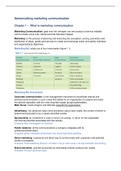Samenvatting marketing communication
Chapter 1 – What is marketing communication
Marketing Communication: gaat over het verkopen van een product of service middels
communicatie (coca cola, James bond de Heineken flesjes)
Marketing: is the process of planning and executing the conception, pricing, promotion and
distribution of ideas, goods and services to create and exchange value, and satisfy individual
and organisational objectives.
Marketing Mix: exists out of four instruments (figure 1.1)
Marketing Mix Instruments
Corporate communication: is the management instrument to coordinate internal and
external communication in such a way that allows for an organisation to acquire and retain
the desired reputation with the most important target groups/stakeholders.
Main focus: create imagine and attitudes towards the organisation.
Advertising: non-personal mass communications using mass media, the content of which is
determined and paid for by a clearly identified sender.
Sponsorship: an investment in cash or kind in an activity, in return for the exploitable
commercial potential associated with this activity.
Example: Max Verstappen en Red Bull
Public relations: all the communications a company instigates with its
audiences/stakeholders.
Example: press releases/conferences that should generate publicity.
Direct marketing: a personal and direct way to communicate with customers and potential
clients or prospects.
Example: Postcodeloterij (brieven of folders met je naam erop in de bijvoorbeeld met korting)
Brand activation: activate consumers by stimulating interest, product trail, loyalty
Example: through personal sales
,Sales promotion: sales-stimulating campaigns
Example: price-cuts, free samples, coupons etc.
Point-of-purchase communications: communications at the point of purchase or point of
sales, also part of brand activation.
Example: specifieke stellingen in de winkel voor producten, displays of merchandising.
Online communication: communicate interactively with customers/stakeholders through the
internet/mobile/devices/social media.
Example: adds op websites maar ook Tiktok of Facebook etc.
Personal vs Mass communication
Personal communication: When the message transfer is directed to certain known and
individually addressed persons, marketing communications.
Mass communication: When it’s directed to a number of receivers who cannot be identified,
using mass media, it’s called mass communications.
Personal communication: online communication, brand activation* and direct marketing.
Mass communication: advertising, online communication, point-of-purchase*, sales
promotion*, public relations and sponsorship
*Not clear-cut.
Integrated marketing communication (IMC): a concept of marketing communication
planning that recognizes the added value of a comprehensive plan that evaluates the
strategic roles of a variety of communication disciplines e.g. general advertising, direct
response, sales promotion and public relation and combines these disciplines to provide
clarity, consistency and maximum communication impact.
Perspective of the recipient
Two important principles when designing and implementing an IMC mix:
Synergy: marketing mix instruments have to be designed in such a way that the effects of
the tools are mutually reinforcing (bigger outcome together then all separately: 1 + 1 = 3?).
Consistency: all marketing instruments have to work in the same direction, and not conflict
with each other.
,International marketing communication
Standardisation (globalisation van de marketing) product voor de internationale markt en
campagne die in elk land hetzelfde concept, setting, thema of boodschap heeft.
Kenmerken: Lagere kosten door economische schaalvoordelen, versterkt kwaliteit en
sterkere globale brand.
Adaption (localisation van de marketing) product aangepast aan het land of de lokale
bevolking/omstandigheden
Kenmerken: duur, goede fit met lokale markt en verhoogt congruentie van eigen merk.
Bijv.: maharadja burger of de Mac Kroket bij de Mac Donalds
Figure 1.2 The marketing mix and integraded marketing communications
Over dit model maakt hij 3 tentamenvragen
Characteristics of integrated marketing communication (IMC) according to De
Pelsmacker et al. (2017):
1. Centered around receiver
2. Dialogue
3. With a flow of information
Tangible product: product features (quality, design, etc.) by which a core benefit can be
made tangible.
Augmented product: ‘service layer’ on top of the tangible product (it gives the tangible
product more value and more customer appeal).
, Corporate communications can be defined as the visualization of corporate identity. To
understand what the core concept of corporate identity means, its link with a number of
related concepts has to be discussed.
• Corporate personality: the values held by personnel within the organization.
• Corporate identity: the set of meanings by which a company allows itself to be
known and through which it allows people to describe, remember and relate to it.
• Industry identity: involves underlying economic and technical characteristics of an
industry, such as industry size, growth, competitiveness, culture and technology
levels.
• Corporate culture: the deeper level of basic assumptions and beliefs that are shared
by members of an organization, that operate unconsciously and define in a basic
“taken-for-granted” fashion an organization’s view of itself and its environment.
• Corporate structure: consists of organizational structure and brand structure.
Organizational structure is concerned with the lines of communication and reporting
responsibilities within the organization.






